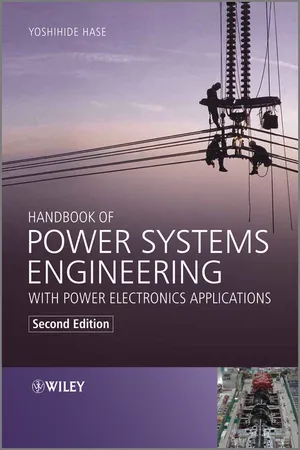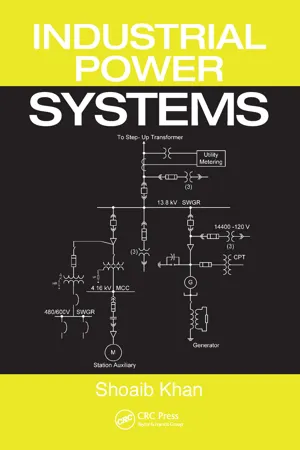Physics
Electric Cables
Electric cables are conductive materials used to transmit electrical power or signals. They are typically made of copper or aluminum wires surrounded by insulation to prevent electrical leakage and protect against environmental factors. Cables are essential components in electrical circuits, providing a means for the flow of electricity from a power source to various devices and systems.
Written by Perlego with AI-assistance
6 Key excerpts on "Electric Cables"
Learn about this page
Index pages curate the most relevant extracts from our library of academic textbooks. They’ve been created using an in-house natural language model (NLM), each adding context and meaning to key research topics.
- eBook - ePub
Electrical Equipment
A Field Guide
- B. Koti Reddy(Author)
- 2021(Publication Date)
- Wiley-Scrivener(Publisher)
10 Cables and Overhead Conductors10.1 Introduction
A conductor in an electrical power network is an element which permits flow of electric current through it by offering low resistance. The most commonly used conducting material is either aluminum or copper. If they are used without any insulating cover over them, they are called bare conductor such as overhead lines with aluminums conductors. If they are covered with an insulation material such as PVC; they are called as cable.A cable is nothing but either a single or multi-conductor, used to transmit and distribute electrical energy, communication signals or radio TV signals. They can be used from LV to HV and can be laid overhead, underground or in water.10.2 Conducting Materials
Aluminum is widely used as electricity conductor due to its lower cost, more availability, very malleable and excellent resistance to corrosion. However, due to added advantages of low resistance; copper is used for most of the low-voltage domestic applications and industrial side up to a certain size. Copper is not preferred at higher sizes due to its cost issues. The main comparisons between aluminum and copper are shown in Table 10.1 - eBook - ePub
- Adrian Waygood(Author)
- 2018(Publication Date)
- Routledge(Publisher)
Chapter 8 Conductors and cablesObjectives
On completion of this chapter, you should be able to- identify, and state the function of, each of the main components of an electric cable.
- explain why some conductors are stranded rather than solid.
- explain how the cross-sectional area of a stranded conductor may be determined.
- explain why the sectional shape of larger multicore cable conductors are frequently ‘wedge’ shaped, rather than circular.
- list the main properties required of a cable’s insulation.
- explain the relationship between a cable’s length and the resistance of its insulation.
- identify the function of a cable conductor by the colour of its insulation.
Introduction
In the electrotechnology industry, ‘wires’ are more-properly called ‘conductors ’. A conductor may be solid or stranded, insulated or uninsulated.An electric cable normally consists of one or more metal current-carrying conductors , each surrounded by a layer of insulation which, in turn, is usually covered by a tough outer protective sheath . In some cases, the cable may be further protected by metal tape or wire armour .In this chapter, we will confine our descriptions to to low- and medium-voltage cables used for the wiring of residential, commercial and industrial installations.The complicated construction of high-voltage underground cables requires extensive explanations based upon an understanding of electric fields which are beyond the level of this book.Conductors
As already explained, in the electrotechnology industry, ‘wires’ are more-properly called ‘conductors ’.A cable may have one, two, three or more separately insulated conductors. Each insulated conductor is called a core , and cables with more than one core are referred to as multicore cables (or, in North America, ‘multi-conductor’ cables).The very best metal conductor is silver which, because of its cost, is limited to special applications such as relay contacts, printed circuit boards, etc. It’s common to compare the conductivity of other conductors to that of silver, as indicated in Table 8.1 - eBook - ePub
- William A. Thue, William A. Thue(Authors)
- 2017(Publication Date)
- CRC Press(Publisher)
Conductors may be solid or stranded. Metals used are commonly copper or aluminum. An attempt to use sodium was short-lived. The strand can be concentric, compressed, compacted, segmental, or annular to achieve desired properties of flexibility, diameter, and current density. The introduction of steel strands, higher strength aluminum alloys, hard drawn copper, Alumoweld, and Copperweld is common in overhead applications requiring greater tensile strength or other applications with the same requirements.Assuming the same cross-sectional area of the conductor, there is a difference in the diameters between solid and various stranded conductors. This diameter differential is an important consideration in selecting the methods to effect joints, terminations, and fill of conduits.Conductors are covered in Chapter 3 .2.11.4 ELECTRICAL INSULATION (DIELECTRIC )The insulation (dielectric) provides sufficient separation between the conductor and the nearest electrical ground to adjacent phase to preclude dielectric failure. For low voltage cables, the required thickness of insulation to physically protect the conductor is more than adequate for the required dielectric strength.2.11.5 ELECTRIC FIELDEmphasis will be on 60 Hz alternating current fields (50 Hz is more common internationally). In all cables, regardless of their kilovolt ratings, there exists an electric field whenever the conductor is energized. This electric field can be visualized as electric field lines and lines of equipotential (see Figure 2.1 ).2.11.6 EQUIPOTENTIAL LINESEquipotential lines represent points of equal potential difference between electrodes having different electrical potentials. REFERENCES1 . Landinger, C. C., 2001, adapted from class notes for “Understanding Power Cable Characteristics and Applications,” University of Wisconsin–Madison.2 . Clapp, A., Landinger, C. C., and Thue, W. A., September 15–20, 1996, “Design and Application of Aerial Systems Using Insulating and Covered Wire and Cable,” Proceedings of the 1996 IEEE/PES Transmission and Distribution Conference - eBook - ePub
- Ed Sobey(Author)
- 2007(Publication Date)
- Chicago Review Press(Publisher)
8 CABLES AND WIRES
DIGITAL AGE ANXIETY RISES when you have to take your computer away from your desk for maintenance. That tangle of cables that was hidden from sight now rears its ugly head. Do you carefully label every wire and where it connected? Or do you think you can figure it out when you bring the computer back?Cable technology has progressed in step with the other elements of the computer family to generate a bewildering array of wires, each with its own name and function. Specialized cables exist for video download, printer and monitor access, and digital cameras. In some cables the wires run parallel to each other, while in others they are a twisted pair. Still others have one cable inside the other.The good news is that cables are getting smarter. Older cables are wires wrapped in insulation, hopefully with idiot-proof jacks on each end. Newer computer cables are wires wrapped in insulation with integrated circuits in the end plugs that make connecting machines much easier.There’s no reason to shy away from cables. Step up and master cable terminology to blow away the IT folks.Electric Cable
BEHAVIOR
Conveys electrical power from wall outlets to a variety of devices.HABITAT
Since most machinery in an office requires electricity, Electric Cables are found everywhere.HOW IT WORKS
Inside most Electric Cables and extension cords are two or three metal wires that conduct electricity. The wires, made of copper or other good conducting metal, are separately insulated with a plastic. In most cables and extension cords, a third wire for grounding is laid next to the first two and the bundle is covered by another layer of insulation.Electric current flows through the two inner wires. One is connected to the “hot” or higher voltage side of the transformer (which is outside on the ground, or mounted on a utility pole) and other is connected to the “center tap” of the transformer. The flow of electrons through the circuit powers equipment. - Yoshihide Hase(Author)
- 2012(Publication Date)
- Wiley(Publisher)
Chapter 23 Power Cables and Power Cable Circuits10–60 kV power cable began to prevail around the year 1910. Today, power cable networks have been widely adopted as essential power circuit lines of distribution networks and of high voltage transmission networks of up to 400 kV and 500 kV as well as in industrial factories.Now, understanding the theoretical background of power cable is quite important, because first, power cable is one of the most delicate components among various power system components, and is characterized by extreme longitudinal structure, non self-restoring insulation (in particular of polyethylene for CV cable), and a variety of layout environment and stresses, and so on. Second, the large stray capacitance C is an electrical feature that often causes unique phenomena of power frequency or of higher frequency in combination with inductances L of other equipment within a circuit.In this chapter, we study structures and characteristics of power cables, and then focus on surge phenomena caused on power cables in combination with other power system members such as overhead transmission lines, transformers GIS. Various power frequency phenomena have already been discussed in previous chapters.23.1 Power Cables and Their General Features
23.1.1 Classification
High-voltage power cables of 30 kV or higher can be classified into two types by the difference of insulation materials, and are called simply CV cables and OF cables. The CV cable (Cross-linked polyethylene insulated with Vinyl sheathed cable) has another name, XLPE (Cross-Linked Poly-Ethylene). The main insulation is composed of the solid organic material XLPE.- eBook - ePub
- Shoaib Khan, Sheeba Khan, Ghariani Ahmed(Authors)
- 2018(Publication Date)
- CRC Press(Publisher)
3 ] has covered tests carried out with different types of cables available on the market and their influence on the motor shaft voltages and bearing currents. The type of cable recommended where a sine wave filter is not provided at the drive output is a three-conductor cable with three symmetrically placed ground conductors and a heavy-gauge aluminum sheath as armor. Teck type (steel tape) cables are not acceptable.10.5 CABLE INSULATIONA very important parameter in cable selection is the insulation type. Insulation selection should be based on service life, dielectric characteristics, resistance to flame, mechanical strength and flexibility, temperature capability, moisture resistance, and the type of location where the cable is to be installed. Common insulation types applicable to medium-voltage cables are:• Ethylene propylene rubber (EPR) • Cross-linked polyethylene (XLPE) • Tree-retardant cross-linked polyethylene (TR-XLPE) These insulation materials have replaced the impregnated-paper designs that may still be found in some older installations.10.5.1 STANDARDSCable standards are somewhat fragmented in both North America and internationally, with significant work being undertaken to harmonize the cable standards in Europe under the EU standards and in North America. It is likely to be some time before these two groups of standards are brought together due to the variations in operating voltages between the two areas [4 ].At present there are two groups of standards for cables used in North America, one group produced by the Association of Edison Illuminating Companies (AEIC), historically representing the U.S. electrical utilities, and the other by the Insulated Cable Engineers Association (ICEA), which basically standardizes cables for general and industrial use. The ICEA is representative of the cable manufacturers and is the cable manufacturing arm of the U.S. National Electrical Manufacturers Association (NEMA). Both these groups issue voluntary standards that do not fully come under the ANSI standards.The IEEE, through its Insulated Conductors Committee, monitors the ICEA and AEIC work and has issued some standards in this area. It also monitors the international standards issued by the International Electrotechnical Commission (IEC) on behalf of the U.S. standards organizations. Cables used for low-voltage domestic and commercial installations need to meet the standards issued by the Underwriters Laboratory (UL) [S8





